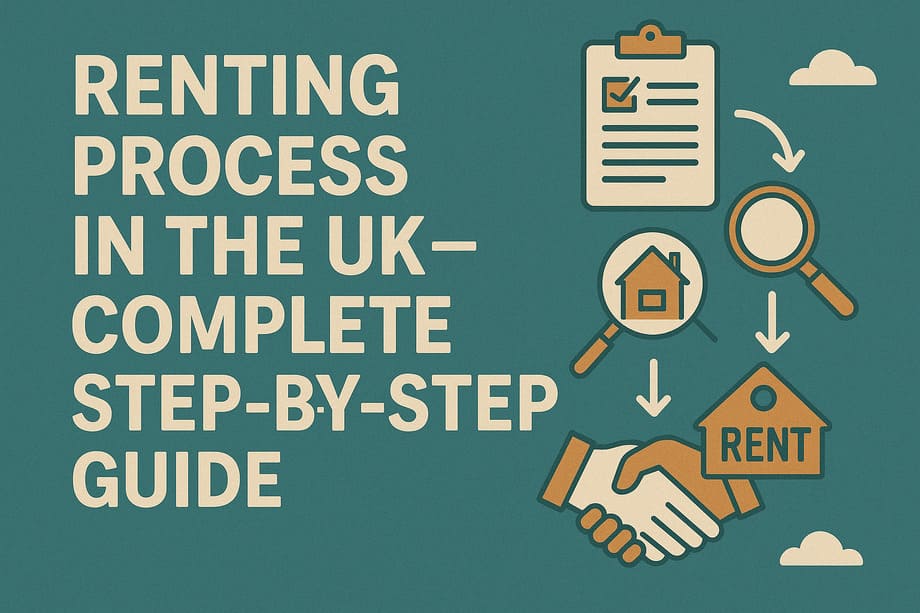Renting Process in the UK – Complete Step-by-Step Guide

Renting your first property in the UK can feel overwhelming. Between understanding deposits, navigating viewings, passing referencing checks, and deciphering tenancy agreements, there’s a lot to get your head around.
This comprehensive guide walks you through every stage of the UK renting process, from working out what you can afford to collecting your keys and settling into your new home. Whether you’re a first-time renter or returning to the rental market after years away, you’ll find everything you need to know right here.
Step 1: Work Out Your Budget and Affordability
Before you start browsing Rightmove or Zoopla, establish what you can realistically afford. Letting agents will scrutinise your finances during the application process, so it pays to be realistic from the start.
Calculate How Much Rent You Can Afford
Financial experts recommend spending no more than 30-35% of your gross income on rent. This leaves enough for bills, food, transport, and savings.
Quick calculation:
- Take your annual gross salary (before tax)
- Multiply by 30%
- Divide by 12 for monthly rent budget
Example: £28,000 annual salary × 30% = £8,400 ÷ 12 = £700 monthly rent maximum
This is your comfortable ceiling. Stretching beyond 35% leaves you vulnerable if unexpected expenses arise or your income changes.
Understand the Upfront Costs
Renting requires significant upfront payment beyond just the first month’s rent.
Security deposit: 5 weeks’ rent for properties under £50,000 annual rent (6 weeks for properties over £50,000)
First month’s rent: Usually paid upfront alongside your deposit
Example for £800 PCM property:
- Weekly rent: £184.62
- Security deposit: £923 (5 weeks)
- First month’s rent: £800
- Total upfront: £1,723
Many first-time renters underestimate these upfront costs. Start saving early if you’re planning to move.
Check Your Credit Score
Landlords and agents run credit checks on all applicants. A poor score won’t automatically disqualify you, but it might require you to provide a guarantor or pay additional rent upfront.
Check your credit report for free through:
- Experian
- ClearScore
- Credit Karma
Look for any errors or issues you can resolve before applying for properties. County Court Judgements (CCJs), defaults, or bankruptcies will raise red flags.
Consider Whether You Need a Guarantor
A guarantor is someone (usually a parent or close relative) who agrees to cover your rent if you can’t pay. You’ll likely need a guarantor if:
- Your income is below the required threshold (typically 2.5-3x monthly rent)
- You have a poor credit history
- You’re a student or in your first job
- You’re self-employed with variable income
Guarantors must pass their own credit and affordability checks, so confirm they’re willing and able before you apply.
Step 2: Search for Properties
Once you’ve established your budget, start searching for properties that meet your needs and financial constraints.
Decide on Your Must-Haves
Be clear about what’s essential versus what’s desirable:
Essential factors:
- Monthly rent within your budget
- Number of bedrooms needed
- Location (work commute, schools, amenities)
- Available from your required move-in date
Desirable factors:
- Garden or outside space
- Parking
- Furnished or unfurnished
- Modern kitchen or bathroom
In competitive markets, you’ll likely need to compromise on some desirable factors to find something within budget and available when you need it.
Understand Furnished vs Unfurnished
Furnished properties include:
- All white goods (fridge, washing machine, oven)
- Beds and wardrobes
- Sofas and dining furniture
- Basic curtains or blinds
Unfurnished properties usually include:
- White goods only
- Sometimes carpets and curtain fixtures
- No other furniture
First-time renters often prefer furnished properties to avoid the expense of buying furniture. However, unfurnished properties let you make the space your own with your belongings.
Use Reputable Property Portals and Agents
Stick to major property portals to avoid scams:
- Rightmove
- Zoopla
- OnTheMarket
- SpareRoom (for house shares)
When dealing with letting agents, check they’re members of:
- ARLA (Association of Residential Letting Agents)
- RICS (Royal Institution of Chartered Surveyors)
- Property Ombudsman or Property Redress Scheme
Membership in these organisations provides accountability and dispute resolution if things go wrong.
Spot and Avoid Rental Scams
Be wary of these red flags:
- Landlord refuses to meet or show the property in person
- Request for payment or deposit before viewing
- Property advertised significantly below market value
- Landlord claims to be abroad and can’t show property
- Pressure to pay immediately without proper paperwork
Never pay any money until:
- You’ve viewed the property in person
- Verified the landlord or agent is legitimate
- Received proper documentation
Step 3: View Properties
Viewings are your opportunity to inspect properties thoroughly and assess whether they suit your needs.
What to Check During Viewings
Property condition:
- Test taps, showers, and toilets
- Turn on lights and check electrical sockets
- Open windows and check locks
- Look for damp, mould, or structural issues
- Check mobile phone signal strength
Security:
- Quality of door and window locks
- Burglar alarm (if present)
- Well-lit entrances and exits
- Secure bike storage or parking
Practical considerations:
- Adequate storage space
- Water pressure in shower
- Heating system type and controls
- Noise levels from neighbours or traffic
Measurements:
- Take room measurements to ensure your furniture fits
- Check ceiling height if you have tall furniture
Questions to Ask the Agent or Landlord
- What’s included in the rent?
- Who’s responsible for utility bills?
- Is council tax included?
- When is the property available?
- How long is the tenancy term?
- Are pets allowed?
- Can I decorate or make minor alterations?
- How long has the current/previous tenant lived here?
- Why are they leaving?
- How responsive is the landlord to maintenance issues?
Don’t be afraid to ask questions. Agents expect it, and asking shows you’re serious and thorough.
View Multiple Times
If you’re keen on a property, request a second viewing. View at different times of day to assess:
- Noise levels during evenings or weekends
- Natural light at different times
- Parking availability (if relevant)
A second viewing also lets you bring someone else for a second opinion.
Step 4: Submit Your Application
Found the perfect property? You’ll need to move quickly in competitive markets.
Pay a Holding Deposit
A holding deposit reserves the property while your application is processed. Under the Tenant Fees Act 2019, holding deposits are capped at one week’s rent.
The holding deposit should be:
- Refunded within 7 days if your application is rejected (through no fault of your own)
- Deducted from your first rent payment or security deposit if your application succeeds
Landlords can keep your holding deposit if:
- You provide false or misleading information
- You withdraw your application
- You fail Right to Rent checks
Gather Required Documents
Prepare these documents for your application:
Proof of identity:
- Passport or driving licence
- Recent utility bill or bank statement showing current address
Proof of income:
- Last 3 months’ payslips (employed)
- Last 2 years’ accounts or tax returns (self-employed)
- Bank statements showing salary deposits
References:
- Previous landlord contact details
- Employer contact details
- Personal reference (character reference)
Right to Rent documents:
- UK/Irish passport
- Biometric Residence Permit
- Share code (if you have settled/pre-settled status)
Having everything ready speeds up the application process significantly.
The Referencing Process
Letting agents conduct several checks:
Credit check: Reviews your credit history, CCJs, defaults, and bankruptcies
Affordability check: Verifies your income meets the requirement (usually 2.5-3x monthly rent)
Previous landlord reference: Confirms you paid rent on time, maintained the property, and gave proper notice
Employer reference: Verifies your employment, salary, and job security
Right to Rent check: Confirms you have legal permission to rent in the UK (England only)
This process typically takes 3-7 days, depending on how quickly references respond.
Step 5: Review and Sign the Tenancy Agreement
Once you pass all checks, you’ll receive your tenancy agreement to review and sign.
Understanding Your Tenancy Agreement
Most UK tenancies are Assured Shorthold Tenancies (ASTs). Your agreement should clearly state:
Basic details:
- Names and addresses of all parties (tenant, landlord, agent)
- Property address
- Tenancy start and end dates
- Monthly rent amount and payment date
Financial terms:
- Deposit amount and protection scheme details
- Late payment charges (if any)
- Who pays which bills
Rights and responsibilities:
- Landlord’s repair obligations
- Your maintenance responsibilities
- Property access for inspections (minimum 24 hours’ notice)
- Rules on pets, smoking, decorating
Break clauses:
- Conditions for ending tenancy early
- Notice periods required
Read everything carefully before signing. If anything is unclear, ask the agent or landlord to explain it. Once signed, this is a legally binding contract.
Understand Fixed-Term vs Periodic Tenancies
Fixed-term tenancy:
- Set length (usually 6 or 12 months)
- Cannot be ended early unless break clause exists
- Rent can only increase with your agreement during fixed term
Periodic tenancy:
- Rolls month-to-month or week-to-week
- Either party can end with proper notice (usually 1-2 months)
- Landlord can increase rent once per year with proper notice
Most tenancies start as fixed-term, then become periodic when the fixed term ends unless you sign a new agreement.
Step 6: Pay Deposit and Rent
After signing your agreement, you’ll pay your security deposit and initial rent.
Security Deposit Protection
By law, your landlord must protect your deposit in a government-approved scheme within 30 days:
- Deposit Protection Service (DPS)
- MyDeposits
- Tenancy Deposit Scheme (TDS)
Your landlord must provide you with:
- Information about which scheme holds your deposit
- Certificate or reference number
- Details of the prescribed information
This protection ensures you get your deposit back at the end of the tenancy (minus any legitimate deductions for damage or unpaid rent).
Setting Up Rent Payments
Most landlords require rent by standing order—an automatic monthly payment from your bank account.
Set the standing order to pay rent 1-2 days before the due date to ensure it arrives on time, accounting for processing delays.
Keep records of every rent payment:
- Bank statements showing payments
- Payment references
- Dates and amounts
This protects you if any disputes arise about payment history.
Step 7: Understand Your Bills and Responsibilities
Moving into your new home comes with various bills and responsibilities.
Bills You’ll Typically Pay
Council tax: £1,200-£2,400 annually (varies by area and property band)
- You may get a 25% discount if living alone
- Full-time students are exempt
Gas and electricity: £80-£150 monthly average
- Compare suppliers to find the best deal
- Consider fixing rates to avoid price fluctuations
Water: £30-£50 monthly average
- Usually paid to your water company
- Some properties have water meters
Internet and phone: £20-£40 monthly
- Shop around for deals
- Check coverage in your area
TV licence: £159 annually
- Required if you watch live TV or BBC iPlayer
- One licence covers the whole property
Total estimated monthly bills: £250-£450 on top of rent
When Rent Includes Bills
Some properties, particularly HMOs (houses in multiple occupation), include bills in the rent. Always clarify:
- Which bills are included
- Any usage caps or limits
- What happens if usage exceeds limits
Setting Up Utility Accounts
After receiving your keys:
- Take meter readings on move-in day (photograph them)
- Contact utility companies to switch accounts to your name
- Submit your opening meter readings
- Register for council tax with your local council
Taking opening meter readings protects you from paying for the previous tenant’s usage.
Step 8: Complete the Inventory Check
Before moving in, you’ll receive an inventory and condition report documenting the property’s condition.
Why the Inventory Matters
This report protects both you and your landlord. It records:
- Condition of walls, floors, and fixtures
- Any existing damage or wear
- Contents included (furniture, appliances)
- Meter readings
At the end of your tenancy, this inventory is compared against the property’s condition to determine if any deposit deductions are justified.
What to Do:
- Review the inventory thoroughly
- Note any discrepancies or damage not recorded
- Take photos and videos of everything
- Report inaccuracies to your landlord/agent within 7 days
- Keep your copy safe
Being thorough now prevents disputes when you move out.
Step 9: Know Your Rights and Responsibilities
Understanding your legal rights and responsibilities helps avoid conflicts.
Your Responsibilities as a Tenant
Pay rent on time: Missing payments can lead to eviction
Maintain the property: Keep it clean and report damage promptly
Allow access for repairs: Landlords must give 24 hours’ notice except for emergencies
Don’t make unauthorised changes: Get written permission before decorating or alterations
Respect neighbours: Avoid anti-social behaviour or excessive noise
Your Landlord’s Responsibilities
Maintain the property’s structure: Roof, walls, windows, doors
Repair installations: Heating, water, electricity, sanitation
Ensure gas and electrical safety: Annual gas safety checks, electrical inspections
Protect your deposit: In government-approved scheme within 30 days
Provide 24 hours’ notice: Before entering property (except emergencies)
How to Report Repairs
When something breaks or needs repair:
- Report it to your landlord/agent immediately
- Use email or written communication for records
- Give reasonable access for repairs
- Follow up if repairs aren’t completed
For emergencies (gas leaks, flooding, no heating in winter), your landlord must respond immediately.
Ending Your Tenancy
When you’re ready to leave:
During fixed term:
- Check if your agreement has a break clause
- Give the required notice (usually 1-2 months)
- Notice must be in writing
During periodic tenancy:
- Give the notice period stated in your agreement (usually 1 month)
- Notice must be in writing
Before moving out:
- Professional clean the property
- Repair any damage you caused
- Remove all your belongings
- Return all keys
- Take photos of the property’s condition
Following these steps maximises your chances of getting your full deposit back.
Common Questions About Renting in the UK
How long does the renting process take?
From viewing a property to moving in typically takes 2-4 weeks. This includes application processing (3-7 days), referencing checks (5-10 days), and signing contracts. In competitive markets, be prepared to move quickly, popular properties can be let within 48 hours of listing.
Can I rent with bad credit?
Yes, but it’s more challenging. Options include providing a guarantor (someone with good credit who’ll cover rent if you can’t pay), paying several months’ rent upfront, or looking for landlords who specialise in tenants with poor credit. Be honest about your credit history lying will result in rejection.
What is the 30% rule for rent?
The 30% rule suggests spending no more than 30% of your gross monthly income on rent. This leaves sufficient income for bills, food, transport, and savings. For example, if you earn £2,000 monthly, aim for rent below £600. In expensive cities, many people spend 40-50%, but this leaves less financial cushion.
Do I need renter’s insurance?
While not legally required, tenant contents insurance is highly recommended. Your landlord’s buildings insurance doesn’t cover your belongings. Contents insurance (typically £5-£15 monthly) protects your possessions against theft, fire, flood, and damage. Some policies include liability cover if you accidentally damage the property.
Can my landlord increase the rent?
During a fixed-term tenancy, landlords can only increase rent if you agree or if a rent review clause exists in your agreement. After the fixed term ends, landlords can increase rent once per year by giving proper notice (usually 1 month for monthly tenancies). You can challenge increases you believe are excessive.
Key Takeaways
Budget realistically before you start searching – Use the 30% rule and remember upfront costs typically equal 2-3 months’ rent including deposit and first month’s payment.
Prepare documents early – Having ID, payslips, bank statements, and references ready speeds up your application significantly.
View properties thoroughly – Check everything during viewings and don’t hesitate to ask questions. Request second viewings for properties you’re seriously considering.
Understand the tenancy agreement – Read everything carefully before signing. This legally binding contract defines your rights and responsibilities for months or years.
Document the property’s condition – Take photos when moving in and review the inventory meticulously. This protects your deposit when you move out.
Know your rights and responsibilities – Understanding what you and your landlord are each responsible for prevents disputes and ensures issues get resolved quickly.
Protect your deposit – Confirm it’s registered in a government-approved scheme within 30 days. Keep the registration certificate safe.
The UK renting process involves multiple steps, but understanding each stage makes it far less daunting. Take your time, do your research, and don’t rush into commitments. With proper preparation and knowledge, you’ll find a property that meets your needs and budget while protecting yourself throughout the process.
Last Updated on October 23, 2025 by James Cartwright







